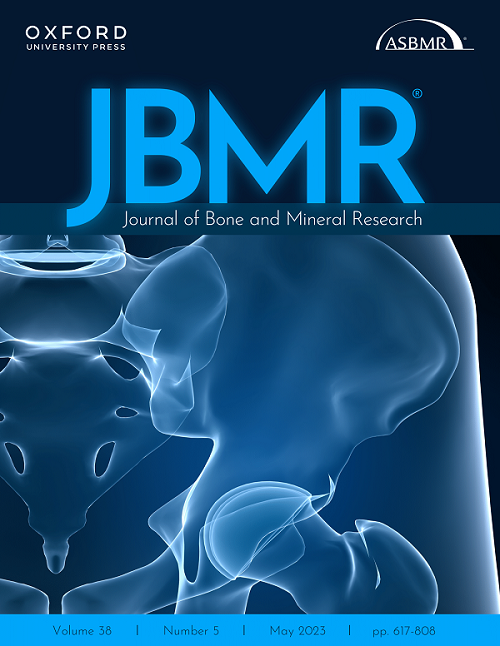Stefan Bartenschlager, Alexander Cavallaro, Tobias Pogarell, Oliver Chaudry, Michael Uder, Sundeep Khosla, Georg Schett, Klaus Engelke
下载PDF
{"title":"Opportunistic Screening With CT: Comparison of Phantomless BMD Calibration Methods","authors":"Stefan Bartenschlager, Alexander Cavallaro, Tobias Pogarell, Oliver Chaudry, Michael Uder, Sundeep Khosla, Georg Schett, Klaus Engelke","doi":"10.1002/jbmr.4917","DOIUrl":null,"url":null,"abstract":"<p>Opportunistic screening is a new promising technique to identify individuals at high risk for osteoporotic fracture using computed tomography (CT) scans originally acquired for an clinical purpose unrelated to osteoporosis. In these CT scans, a calibration phantom traditionally required to convert measured CT values to bone mineral density (BMD) is missing. As an alternative, phantomless calibration has been developed. This study aimed to review the principles of four existing phantomless calibration methods and to compare their performance against the gold standard of simultaneous calibration (ΔBMD). All methods were applied to a dataset of 350 females scanned with a highly standardized CT protocol (DS1) and to a second dataset of 114 patients (38 female) from clinical routine covering a large range of CT acquisition and reconstruction parameters (DS2). Three of the phantomless calibration methods must be precalibrated with a reference dataset containing a calibration phantom. Sixty scans from DS1 and 57 from DS2 were randomly selected for this precalibration. For each phantomless calibration method first the best combination of internal reference materials (IMs) was selected. These were either air and blood or subcutaneous adipose tissue, blood, and cortical bone. In addition, for phantomless calibration a fifth method based on average calibration parameters derived from the reference dataset was applied. For DS1, ΔBMD results (mean <math>\n <mrow>\n <mo>±</mo>\n </mrow></math> standard deviation) for the phantomless calibration methods requiring a precalibration ranged from 0.1 <math>\n <mrow>\n <mo>±</mo>\n </mrow></math> 2.7 mg/cm<sup>3</sup> to 2.4 <math>\n <mrow>\n <mo>±</mo>\n </mrow></math> 3.5 mg/cm<sup>3</sup> with similar means but significantly higher standard deviations for DS2. Performance of the phantomless calibration method, which does not require a precalibration was worse (ΔBMD DS1: 12.6 <math>\n <mrow>\n <mo>±</mo>\n </mrow></math> 13.2 mg/cm<sup>3</sup>, DS2: 0.5 <math>\n <mrow>\n <mo>±</mo>\n </mrow></math> 8.8 mg/cm<sup>3</sup>). In conclusion, phantomless BMD calibration performs well if precalibrated with a reference dataset. © 2023 The Authors. <i>Journal of Bone and Mineral Research</i> published by Wiley Periodicals LLC on behalf of American Society for Bone and Mineral Research (ASBMR).</p>","PeriodicalId":185,"journal":{"name":"Journal of Bone and Mineral Research","volume":"38 11","pages":"1689-1699"},"PeriodicalIF":5.1000,"publicationDate":"2023-09-21","publicationTypes":"Journal Article","fieldsOfStudy":null,"isOpenAccess":false,"openAccessPdf":"https://asbmr.onlinelibrary.wiley.com/doi/epdf/10.1002/jbmr.4917","citationCount":"0","resultStr":null,"platform":"Semanticscholar","paperid":null,"PeriodicalName":"Journal of Bone and Mineral Research","FirstCategoryId":"3","ListUrlMain":"https://onlinelibrary.wiley.com/doi/10.1002/jbmr.4917","RegionNum":1,"RegionCategory":"医学","ArticlePicture":[],"TitleCN":null,"AbstractTextCN":null,"PMCID":null,"EPubDate":"","PubModel":"","JCR":"Q1","JCRName":"ENDOCRINOLOGY & METABOLISM","Score":null,"Total":0}
引用次数: 0
引用
批量引用
Abstract
Opportunistic screening is a new promising technique to identify individuals at high risk for osteoporotic fracture using computed tomography (CT) scans originally acquired for an clinical purpose unrelated to osteoporosis. In these CT scans, a calibration phantom traditionally required to convert measured CT values to bone mineral density (BMD) is missing. As an alternative, phantomless calibration has been developed. This study aimed to review the principles of four existing phantomless calibration methods and to compare their performance against the gold standard of simultaneous calibration (ΔBMD). All methods were applied to a dataset of 350 females scanned with a highly standardized CT protocol (DS1) and to a second dataset of 114 patients (38 female) from clinical routine covering a large range of CT acquisition and reconstruction parameters (DS2). Three of the phantomless calibration methods must be precalibrated with a reference dataset containing a calibration phantom. Sixty scans from DS1 and 57 from DS2 were randomly selected for this precalibration. For each phantomless calibration method first the best combination of internal reference materials (IMs) was selected. These were either air and blood or subcutaneous adipose tissue, blood, and cortical bone. In addition, for phantomless calibration a fifth method based on average calibration parameters derived from the reference dataset was applied. For DS1, ΔBMD results (mean
±
standard deviation) for the phantomless calibration methods requiring a precalibration ranged from 0.1
±
2.7 mg/cm3 to 2.4
±
3.5 mg/cm3 with similar means but significantly higher standard deviations for DS2. Performance of the phantomless calibration method, which does not require a precalibration was worse (ΔBMD DS1: 12.6
±
13.2 mg/cm3 , DS2: 0.5
±
8.8 mg/cm3 ). In conclusion, phantomless BMD calibration performs well if precalibrated with a reference dataset. © 2023 The Authors. Journal of Bone and Mineral Research published by Wiley Periodicals LLC on behalf of American Society for Bone and Mineral Research (ASBMR).
CT的机会筛查:无Phantomle BMD校准方法的比较。
机会筛查是一种很有前途的新技术,可以通过计算机断层扫描(CT)来识别骨质疏松性骨折的高危人群,该扫描最初是为了与骨质疏松症无关的临床目的而获得的。在这些CT扫描中,传统上需要将测量的CT值转换为骨密度(BMD)的校准体模缺失。作为一种替代方案,已经开发了无幻影校准。本研究旨在回顾四种现有的无幻影校准方法的原理,并将其性能与同时校准的金标准(ΔBMD)进行比较。所有方法都应用于用高度标准化CT方案(DS1)扫描的350名女性的数据集,以及来自临床常规的114名患者(38名女性)的第二个数据集,涵盖了大范围的CT采集和重建参数(DS2)。三种无模型校准方法必须使用包含校准模型的参考数据集进行预校准。随机选择来自DS1的60次扫描和来自DS2的57次扫描用于该预校准。对于每种无幻影校准方法,首先选择内部参考材料(IM)的最佳组合。这些要么是空气和血液,要么是皮下脂肪组织、血液和皮质骨。此外,对于无幻影校准,应用了基于从参考数据集导出的平均校准参数的第五种方法。对于DS1,需要预校准的无幻影校准方法的ΔBMD结果(平均值±$$\pm$$标准偏差)范围为0.1±$$\pm$$2.7 mg/cm3至2.4±$$\pm$$3.5 mg/cm3,具有相似的平均值,但DS2的标准偏差明显更高。不需要预先校准的无幻影校准方法的性能较差(ΔBMD DS1:12.6±$$\pm$13.2 mg/cm3,DS2:0.5±$$\pm$$8.8 mg/cm3)。总之,如果使用参考数据集进行预校准,则无幻影BMD校准效果良好。©2023作者。由Wiley Periodicals LLC代表美国骨与矿物研究学会(ASBMR)出版的《骨与矿产研究杂志》。
本文章由计算机程序翻译,如有差异,请以英文原文为准。


 求助内容:
求助内容: 应助结果提醒方式:
应助结果提醒方式:


